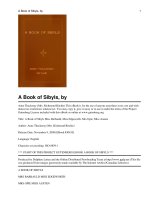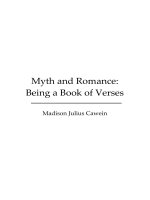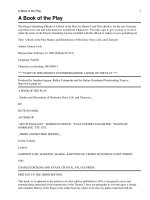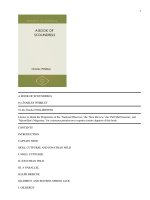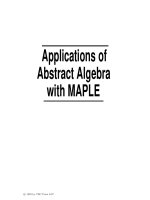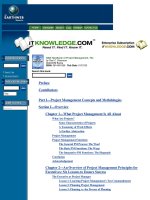A book of abstract algebra by charles c pinter (2nd ed)
Bạn đang xem bản rút gọn của tài liệu. Xem và tải ngay bản đầy đủ của tài liệu tại đây (49.66 MB, 366 trang )
A BOOK OF
ABSTRACT ALGEBRA
Charles C. Pinter
Professor of Mathematics
Bucknell University
McGraw-Hili Book Company
New York St. Louis San Francisco Auckland Bogota Hamburg
Johannesburg London Madrid Mexico Montrcal New Delhi
Panama Paris SlIo Paulo Singapore Sydney Tokyo Toronto
This book was set in Times Roman by Santype-Byrd.
The editors were John J. Corrigan and James S. Arnar;
the production supervisor was Leroy A. Young.
The drawings were done by VIP Graphics.
The cover was designed by Scott Che1ius.
R. R. Donnelley & Sons Company was printer and binder.
A BOOK OF ABSTRACf ALGEBRA
Copyright 10 1982 by McGraw-Hili, Inc. All rights reserved. Printed in the United
States of America. Except as pennitted under the United States Copyright Act of
1976, no part of this publication may be reproduced or distributed in any form or
by any means, or stored in a data base or retrieval system, without the prior written
pennission of the publisher.
1234567890 DODO 8987654321
ISBN 0-07-050130-0
Ubrllry of Congress Clltaloging in Publication Dlltll
Pinter, Charles C, date
A book of abstract algebra.
Includes index.
\. Algebra, Abstract.
QA162.P56
512'.02
ISB N 0-07-050130-0
I. Title.
81-8420
AACR:!
To my colleagues in Brazil, especially
Newton da Costa,
Ayda Arruda, and
Elias Alves,
as well as to others. In appreciation of their loyal and valued friend ship.
CONTENTS'
Preface
xiii
Chapter 1 Why Abstract Algebra?
History of Algebra. New Algebras. Algebraic
Structures. Axioms and Axiomatic Algebra.
Abstractio n in Algebra.
Cbapter 2 Operations
20
Operations o n a Set.
Properties of Operations.
Chapter 3 The Definition of Groups
26
Groups. Examples of Infinite and Finite Groups.
Eumples of Abelian and Nonabelian Groups.
Group Tables.
Chapter 4
Elementary Properties of Groups
36
Uniqueness of Identity and Inverses. Properties of
Inverses.
Direct Product of Groups.
5 Subgroups
45
Definition of Subgroup. Generators and Defining
Relations.
Cayley Diagrams.
Center of Q Group .
• Italic beadings indicate topics discussed in the exercise sections.
vii
yiii CONTENTS
Chapter 6 Functions
54
Injective,.Surjective, Bijective Function . Composite and
Inverse of Functions.
Chapter 7 Groups of Permutations
Symmetric Groups.
64
Dihedral Groups.
Chapter 8 Permutations of a Finite Set
75
Decomposition of Permutations into Cycles.
Transpositions. Even and Odd Permutations.
Alternating Groups.
Chapter 9 Isomorphism
86
The Concept of Isomorphism in Mathematics.
Isomorphic and Nonisomorphic Groups.
Cayley's Theorem.
Group Automorphistm.
Chapter 10 Order of Group Elements
100
Powers/ Multiples of Group Elements. Laws of
Exponents. Properties of the Order of Group
Elements.
Chapter 11
Cyclic Groups
109
Finite and Infinite Cyclic Groups. Isomorphism of
Cyclic Groups. Subgroups of Cyclic Groups.
Chapter 12 Partitions and Equivalence Relations
117
Chapter 13 Counting Cosets
123
Lagrange's Theorem and Elementary Consequences.
Number a/Conjugate Elements. Group Acting on a Set.
Survey a/Group$ a/Order.:S 10.
Chapter 14 Homomorphisms
Elementary Properties of Homomorphism.
Subgroups. Kernel and Range.
Inner Direct Products. Conjugate Subgroup$.
132
Normal
CONTENTS ix
Chapter 15 Quotient Groups
Quotient Group Construction.
Applications.
The Class Equation.
143
Exam,ples and
Induction on the Order of a Group.
Chapter 16 The Fundamental Homomorphism Theorem
153
Fundamental Homomorphism Theorem and Some
Consequences.
The Isomorphism Theorems. The Corre$pomience Theorem.
Cauchy'$ Theorem. Sylow Subgroups. Sylow's Theorem.
Decomposition Theorem for Finite Abelian Groups.
Chapter 17
Rings: Definitions and
Elementary Properties
165
Commutative Rings. Unity. Invertibles and
Zero-Divisors. Integral Domain. Field.
Chapter 18 Ideals and Homomorphisms
178
Chapter 19 Quotient Rings
187
Construction of Quotient Rings. Examples.
Fundamental Homomorphism Theorem and Some
Consequences. Properties of Prime and Maximal
Ideals.
Chapter 20
Integral Domains
197
Characteristic of an Integral Domain . Properties
of the Characteristic. Finite Fields. Construction
of the Field of Quotients.
Chapter 21
The Integers
205
Ordered Integral Domains. Well-ordering.
Characterization of Z Up to Isomorphism. Mathematical
Induction. Division Algorithm.
Chapter 22
Factoring into Primes
Ideals of Z. Properties of the GCn. Relatively
Prime Integers. Primes. Euclid's Lemma. Unique
Factorization.
215
x CONTENTS
Chapter 23 Elements of Number Theory
224
Properties of Congruence. Theorems of Fermat and
Euler. Solutions of Linear Congruences. Chinese
Remainder Theorem.
Wilson's Theorem and Consequences. Quadratic Residues.
The Legendre Symbol. Primitive Roots.
Chapter 24
Rings of Polynomials
239
Motivation and Definitions. Domain of Polynomials
over a Field. Division Algorithm.
Polynomials in Several Voriables.
Chapter 25
Field of Polynomial Quoliem s.
Factoring Polynomials
251
Ideals of F[x). Properties of the GCD.
Polynomials. Unique factorization.
Irreducible
Euclidean Algorithm.
Chapter 26 Substitution in Polynomials
258
Roots and Factors. Polynomial Functions.
Polynomials over O. Eisenstein's Irreducibility
Criterion. Polynomials over the Reals. Polynomial
Interpolation.
Chapter 27
Extensions of Fields
270
Algebraic and Transcendental Elements. The
Minimum Polynomial. Basic Theorem on Field
Extensions.
Chapter 28 Vector Spaces
282
Elementary Properties of Vector Spaces. Linear
Independence. Basis. Dimension. Linear
Transformations.
Chapter 29
Degrees of Field Extensions
Simple and Iterated Extensions.
Extension.
Field of Algebraic Elements.
C/osll1'e.
292
Degree of an Iterated
Algebraic Numbers.
Algebraic
CONTENTS
Chapter 30
Ruler and Compass
xi
301
Constructible Points and Numbers.
Constructions.
Impossible
Conslructible Angles and Polygons.
Chapler 31
Galois Theory: Preamble
Multiple Roots. Root Field.
Isomorphism.
ROOfs of Unity.
311
Extension of a Field
Separable Polynomials.
Normal ExtensiollS.
Chapler 32 Galois Theory: The Hearl of The Matter
323
Field Automorphisms. The Galois Group. The
Galois Correspondence. Fundamental Theorem of
Galois Theory.
Computing Galois Groups.
Chapler 33 Solving Equations by Radicals
Radical Extensions. Abelian Extensions.
Groups. Insolvability of the Quintic.
Index
335
Solvable
347
PREFACE
Once, when I was a student struggling to understand modem algebra, I
was told to view this subject as an intellectual chess game, with conventional moves and prescribed rules of play. I was ill served by this bit of extemporaneous advice, and vowed never to perpetutate the falsehood that mathematics is pureiY-----{)f primarily-a formalism. My pledge has strongly
influenced the shape and style of this book.
While giving due emphasis to the deductive aspect of modern algebra,
I have endeavored here to present modem algebra as a lively branch of
mathematics, having considerable imagin~tive appeal and resting on some
finn, clear, and familiar intuitions. I have devoted a great deal of attention
to bringing out the meaningfulness of algebraic concepts, by tracing these
concepts to their origins in classical algebra and at the same time exploring
their connections with other parts of mathematics, especially geometry,
number theory, and aspects of computation and equation-solving.
In an introductory chapter entitiled Why Abstract Algebra?, as well as
in numerous historical asides, concepts of abstract algebra are traced to the
historic context in which they arose. I have attempted to show that they
arose wi thout artifice, as a natural response to particular needs, in the
course of a natural process of evolution. Furthermore, I have endeavored to
bring to light, explicitly, the intuitive content of the algebraic concepts used
in this book. Concepts are more meaningful to students when the students
are able to represent those concepts in their minds by clear and familiar
mental images. Accordingly, the process of concrete concept-formation is
developed with care throughout this book.
xiii
xi"
PREFACE
I have deliberately avoided a rigid conventional format, with its suc~
cession of definition, theorem, proof, corollary, example. In my experience,
that kind of format encourages some students to believe that mathematical
concepts have a merely conventional character, and may encourage rote
memorization. Instead, each chapter has the form of a discussion with the
student, with the accent on explaining and motivating.
In an effort to avoid fragmentation of the subject matter into loosely
related definitions and results, each chapter is built around a central theme,
and remains anchored to this focal point. In the later chapters, especially,
this focal point is a specific application or use. Details of every topic are
then woven into the general discussion. so as to keep a natural flow of ideas
running through each chapter.
The arrangement of topics is designed to avoid tedious proofs and
long~winded explanations. Routine arguments are worked into the discussion whenever this seems natural and appropriate, and proofs to theor~
ems are seldom more than a few lines long. (There are, of course, a few
exceptions to this.) Elementary background material is filled in as it is
needed. For example, a brief chapter on functions precedes the discussion of
permutation groups, and a chapter on equivalence relations and partitions
paves the way for Lagrange's theorem.
This book addresses itself especially to the average student, to enable
him or her to learn and understand as much algebra as possible. In scope
and subject~matter coverage, it is no different from many other standard
texts. It begins with the promise of demonstrating the unsolvability of the
quintic, and ends with that promise fulfilled. Standard topics are discussed
in their usual order, and many advanced and peripheral subjects are intro~
duced in the exercises, accompanied by ample instruction and commentary.
I have included a copious supply of exercises ~ probably more exercises than in other books at this level. They are designed to offer a wide
range of experiences to students at different levels of ability. There is some
novelty in the way the exercises are organized: at the end of each chapter,
the exercises are grouped into Exercise Sets, each Set containing about six
to eight exercises and headed by a descriptive title. Each Set touches upon
an idea or skill covered in the chapter.
The first few Exercise Sets in each chapter contain problems which are
essentially computational or manipulative. Then, there are two or three Sets
of simple proof~type questions, which require mainly the ability to put ·
together definitions and results with understanding of their meaning. After
that, I have endeavored to make the exercises more interesting by arranging
PREF .... CE xy
them so that in each Set a new result is proved , or new light is shed on the
subject of the chapter.
As a rule, all the exercises have the same weight: very simple exercises
are grouped together as parts ofa single problem, and conversely, problems
which require a complex argument are broken into several subproblems
which the student may tackle in turn, I have selected mainly problems
which have intrinsic relevance, and are not merely drill, on the premiss that
this is much more satisfying to the student.
ACKNOWLEDGMENTS
I would like to express my thanks for the many useful comments and
suggestions provided by colleagues who reviewed this text during the course
of its development, especially to William p, Berlinghoff, Southern Connecticut State College; John Ewing, Indiana University; Grant A, Fraser, The
University of Santa Clara; Eugene Spiegel, University of Connecticut; Sherman K. Stein, University of California at Davis; and William Wickless,
University of Connecticut.
My special thanks go to Carol Napier, mathematics editor at McGrawHill during the writing of this book. She found merit in the manuscript at
an early stage and was a moving spirit in its subsequent development. I am
grateful for her steadfast encouragement, perceptiveness, imagination, and
advice which was always "on target."
Charles C. Pinter
CHAPTER
ONE
WHY ABSTRACT ALGEBRA?
When we open a textbook or abstract algebra for the first time and peruse
the table of contents, we are struck by the unfamiliarity of almost every
topic we see listed. Algebra is a subject we know well, but here it looks
surprisingly different. What are these differences, and how fundamental are
they?
First, there is a major difference in emphasis. In elementary algebra we
learned the basic symbolism and methodology of algebra ; we came to see
how problems of the real world can be reduced to sets of equations and
how these equations can be solved to yield numerical answers. This technique for translating complicated problems into symbols is the basis for all
further work in mathematics and the exact sciences, and is one of the
triumphs of the human mind. However, algebra is not only a technique, it is
also a branch of learning, a discipline, like calculus or physics or chemistry.
It is a coherent and unified body of knowledge which may be studied
systematically, starting from first principles and building up. So the first
difference between the elementary and the more advanced course in algebra
is that, whereas earlier we concentrated on technique, we will now develop
that branch of mathematics called algebra in a systematic way. Ideas and
general principles will take precedence over problem solving. (By the way,
this does not mean that modern algebra has no applications- quite the
opposite is true, ~s we will see soon.)
Algebra at the more advanced level is often described as modern or
2
CIiAPTER ONE
abstract algebra. In fact, both of these descriptions are partly misleading.
Some of the great discoveries in the upper reaches of present-day algebra
(for example, the so-called Galois theory) were known many years before
the American Civil War; and the broad aims of algebra today were clearly
stated by Leibniz in the seventeenth century. Thus, " modern" algebra is not
so very modern, after all! To what extent is it abstract? Well, abstraction is
all relative; one person's abstraction is another person's bread and butter.
The abstract tendency in mathematics is a little like the situation of changing moral codes, or changing tastes in music : What shocks one generation
becomes the norm in the next. This has been true throughout the history of
mathematics.
For example, \000 years ago negative numbers were considered to be
an outrageous idea. After all, it was said, numbers are for counting: we may
have one orange, or two oranges, or·no oranges at aU ; but how can we have
minus an orange? The logisticians, or professional calculators, of those days
used negative numbers as an aid in their computations; they considered
these numbers to be a useful fiction, for if you believe in them then every
linear eq uation ax + b = 0 has a solution (namely x := - bfa, provided
a -:F 0). Even the grea t Diophantus once described the solution of
4x + 6 = 2 as an absurd number. The idea of a system of numeration which
included negative numbers was far too abstract for many of the learned
heads of the tenth century!
The historv of the complex numbers (numbers which involve .J=l) is
very much the same. For hundreds of years, mathematicians refused to
accept them because they couldn't find concrete examples or applications.
(They are now a basic tool of physics.)
Set theory was considered to be highly abstract a few years ago, and so
were other commonplaces of today. Many of the abstractions of modern
algebra are already being used by scientists, engineers, and computer
specialists in their everyday work. They will soon be common fare, respectably "concrete," and by then there will be new " abstractions."
Later in this chapter we will take a closer look at the particular brand
of abstraction used in algebra. We will consider how it came about and why
it is useful.
Algebra has evolved considerably, especially during the past 100 years.
Its growth has been closely linked with the development of other branches
of mathematics, and it has been deeply influenced by philosophical ideas on
the nature of mathematics and the role of logic. To help us understand the
nature and spirit of modern algebra, we should take a brief look at its
ongins.
WHY ABSTRACT ALGEBRA?
3
ORIGINS
The order in which subjects follow each other in our mathematical educalion tends to repeat the historical stages in the evolution of mathematics. In
this scheme, elementary algebra corresponds to the great classical age of
algebra, which spans about 300 yea rs from the sixteenth through the eighteenth centuries. It was during these years that the art of solving equations
became highly developed and modern symbolism was invented.
The word" algebra "- al jebr in Arabic- was first used by Mohammed
of Kharizm, who taught mathematics in Baghdad during the ninth <:entury.
The word may be roughly translated as " reunion," and describes his
method for collecting the terms of an equation in order to solve it. It is an
amusing fact that the word "algebra" was first used in Europe in quite
another context. In Spain barbers were called algebristas, or bonesetters
(they reunited broken bones), because medieval barbers did bonesetting and
bloodletting as a sideline to their usual business.
The origin of the word clearly reflects the actual content of algebra at
that time, for it was mainly concerned with ways of solving equations. In
fa ct, Omar Khayyam, who is best remembered for his brilliant verses on
wine, song, love, and friendship which are collected in the Rubaiyat- but
who was also a great mathematician-ex plicitly defined algebr'a as the
science of solving equations.
Thus, as we enter upon the threshold. of the classical age of algebra, its
central theme is clearly identified as that of solying eq uations. Methods of
solving the linear equation ax + b = 0 and the quadratic ax 2 + bc + c = 0
were well known even before the Greeks. But nobody had yet found a
general solution for cubic equations
x3
+ ax 1 + bx
=
c
or quartic (fourth-degree) equations
x 4 +ax 3 +bx 1 +cx=d
This great accomplishment was the triumph of sixteenth century algebra.
The se~ting is Italy and the time is the Renaissance-an age of high
adventure and brilliant achievement, when the wide world was reawakening
after the long austerity of the Middle Ages. America had just been discovered, classical knowledge had been brought to light, and prosperity had
returned to the great cities of Europe. It was a heady age when nothing
seemed impossible and even the old barriers of birth and rank could be
overcome. Courageous individuals set out for great adventures in the far
4
CI-IAPTER ONE
corners of the earth, while others. now confident once again of the power of
the human mind, were boldly exploring the limits of knowledge in the
sciences and the arts. The ideal was to be bold and many-faceted, to " know
something of everything, and everything of at least one thing." The great
traders were patrons of the arts, the finest minds in science were adepts at
political intrigue and high finance. The study of algebra was reborn in this
lively milieu.
.
Those men who brought algebra to a high level of perfection at the
beginning of its classical age-all typical products of the Italian
Renaissance-were as colorful and extraordinary a lot as have ever appeared in a chapter of history. Arrogant and unscrupulous, brilliant, flamboyant, swaggering, and remarkable, they lived their lives as they did their
work: with style and panache, in brilliant dashes and inspired leaps of the
imagination.
The spirit of scholarship was not exactly as it is today. These men,
in stead of publishing their discoveries, kept them as well-guarded secrets to
be used against each other in problem-solving competitions. Such contests
wcre a popular attraction: heavy bets were made on the rival parties, and
their reputations (as well as a substantial purse) depended on the outcome.
One of the most remarkable of these men was Girolamo Cardan.
Cardan was born in 1501 as the illegitimate son of a famous jurist of the
city of Pavia. A man of passionate contrasts, he was destined to become
famous as a physician, astrologer, and mathematician-and notorious as a
compulsive gambler, scoundrel,. and heretic. After he graduated in medicine,
his efforts to build up a medical practice were so unsuccessful that he and
his wife were forced to seek refuge in the poorhouse. With the help of
friends he became a lecturer in mathematics, and, after he cured the child of
a senator from Milan, his medical career also picked up. He was finally
admitted to the college of physicians and soon became its rector. A brilliant
doctor, he gave the first clinical description of typhus fever, and as his fame
spread he became the personal physician of many of the high and mighty of
his day.
Cardan's early interest in mathematics was not without a practical side.
As an inveterate gambler he was fascinated by what he recognized to be the
laws of chance. He wrote a gamblers' manual entitled Book on Games of
Cllance, which presents the first systematic computations of probabilit!es.
He also needed mathematics as a tool in casting horoscopes, for his fame as
an astrologer was great and his predictions were highly regarded and
sought after. His most important achievement was the publication of a
book called Ars Magna (Tile Great Art), in which he presented sys-
WilY ABSTRACT ALGE BRA ?
5
tematically all the algebraic knowledge of his time. However, as already
stated, much of this knowled ge was the personal secret of its practitioners,
and had to be wheedled out of them by cunning and deceit. The most
important accomplishment of the day, the general solution of the cubic
equation which had been discovered by Tartaglia, was obtained in that
fashion.
Tartaglia's life was as turbulent as any in those days. Born with the
name of Niccol6 Fontana about 1500, he was present at the occupation of
Brescia by the French in 1512. He and his father fled with many others into
a ca thedral for sanctuary, but in the heat of battle the soldiers massacred
the hapless citizens even in that holy place. The father was killed, and the
boy, with a split skull and a deep saber cut across his jaws and palate, was
left for dead. At night his mother stole into the cathedral and managed to
carry him off; miraculously he survived. The horror of what he had witnessed caused him to stammer for the rest of his life, earning him the
nickname Tartaglia, " the stammerer," which he eventually adopted.
Tartaglia received no formal schooling, for that was a privilege of rank
and wealth. However, he taught himself mathematics and became one orthe
most gifted mathematicians of his day. He translated Euclid and Archimedes and may be said to have originated the science of ballistics, for he
wrote a treatise on gunnery which was a pioneering effo,rt on the laws of
falling bodies.
In 1535 Tartaglia found a way of solving any cubic equation of the
form x J + ax 2 = b (that is, without an x term). When he announced his
accomplishment (without giving any details, of course), he was challenged
to an algebra contest by a certain Antonio Fior, a pupil of the celebrated
professor of mathematics Scipio del Ferro. Scipio had already found a
method for solving any cubic equation of the fonn x 3 + ax = b (that is,
without an x 2 term), and had confided his secret to his pupil Fior. It was
agreed that each contestant was to draw up 30 problems and hand the list
to his opponent. Whoever solved the greater number of problems would
receive a sum of money deposited with a lawyer. A few days before the
contest, Tartaglia found a way of extending his method so as to solve any
cubic equation. In less than 2 hours he solved all his opponent's problems,
while his opponent failed to solve even one of those proposed by Tartaglia.
For some time Tartaglia kept his method for solving cubic equations to
himself, but in the end he succumbed to Cardan's accomplished powers of
persuasion. Influenced by Cardan's promise to help him become artillery
adviser to the Spanish army, he revealed the details of his met hod to
Cardan under the promise of strict secrecy. A few years later, to Tartaglia's
6
OiAPTER ONE
unbelieving amazement and indignation, Cardan published Tartaglia's
method in his book Ars Magna. Even though he gave Tartaglia full credit
as the originator of the method, there can be no doubt that he broke his
solemn promise. A bitter dispute arose between the mathematicians, from
which Tartaglia was perhaps lucky to escape alive. He lost his position as
public lecturer at Brescia, and lived out his remaining years in obscurity.
The next great step in the progress of algebra was made by another
member of the same circle. It was Ludovico Ferrari who discovered the
general method for solving quartic equations-equations of the form
X4
+ ax;} + bx 2 + ex = d
Ferrari was Cardan's personal servant. As a boy in Cardan's service he
learned Latin, Greek, and mathematics. He won fame after defeating Tartaglia in a contest in 1548, and received an appointment as supervisor of tax
assessments in Mantua. This position brought him wealth and influence,
but he was not able to dominate his own violent, blasphemous disposition.
He quarreled with the regent of Mantua, lost his position, and died at the
age of 43. Tradition has it that he was poisoned by his sister.
As for Cardan, after a long career of brilliant and u!lscrupulo us
achievement, his luck finally abandoned him. Cardan's so n poisoned his
unfaithful wife and was executed in 1560. Ten years later, Cardan was
arrested for heresy beca use he published a horoscope of Christ's life. He
spent several months in jail and was released after renouncing his heresy
privately, but lost his university position and the right to publish books. He
was left with a small pension which had been granted to him, for some
unaccounta ble reason, by the Pope.
As this colorful time draws to a close, algebra emerges as a major
branch of mathematics. It became clear that methods can be found to solve
many different types of equations. In particular, formulas had been discove red which yielded the roots of all cubic and quartic equations. Now the
challenge was clearly out to take the next step, namely to find a formula for
the roots of equations of degree 5 or higher (in other words, equations with
an x~ term, or an x6 term, or higher).. During the next 200 years, there was
hardly a mathematician of distinction who did not try to solve this problem, but none succeeded. Progress was made in new parts of algebra, and
algebra was linked to geometry with the invention of analytic geometry.
Bul the problem of solving equations of degree higher than 4 remained
unsettled. It was, in the expression of Lagrange, "a challenge to the human
mind ."
It was therefore a great surprise to all mathematicians when in 1824 th.e
WHY ABSTRACT ALGEBRA?
7
work ofa young Norwegian prodigy named Niels Abel came to light. In his
work, Abel showed that there does not exist any Jormufa (in the conventional sense we have in mind) for the roots of an algebraic equation whose
degree is 5 or greater. This sensational discovery brings to a close what is
called the classical age of algebra. Throughout this age algebra was conceived essentially as the science of solving equations, and now the outer
limits of this quest had apparently been reached. In the years ahead, algebra
was to stri ke out in new directions.
THE MODERN AGE
About the time Niels Abel made his remarkable discovery, several mathematicians, working independently in different parts of Europe, began raising questions about algebra which had never been considered before. Their
researches in different branches of mathematics had led them to investigate
"a lgebras" of a very unconventional kind-and in connection wi,th these
algebras they had to find answers to questions which had nothing to do
with solving equations. Their work had important applications, and was
soon to compel mathematicians to greatly enlarge their conception of what
algebra is about.
The new varieties of algebra arose as a perfectly natural development in
connection with the application of mathematics to practical problems. This
is certainly true for the example we are about to look at first.
The Algebra of Matrices
A matrix is a rectangular array of numbers such as
11
0.5
Such arrays come up naturally in many situations, for example, in the
solution of simultaneous linear equations. The above matrix, for instance, is
the matrix oj coefficients of the pair of equations
2x+ lly -3z = O
9x + O.5y + 4z = 0
Since the sol ution of this pair of equations depends only on the coefficients,
8
CI-IAPTER ONE
we may solve it by working on the matrix of coefficients alone and ignoring
everything else.
We may consider the entries of a matrix to be arranged in rows and
columns; the above matrix has two rows which are
(2
11
-3)
(9
and
0.5
4)
and three columns which are
and
It is a 2 x 3 matrix.
To simplify our discussion, we will consider only 2 x 2 matrices in the
remainder of this section.
Matrices are added by adding corresponding entries:
+ b')
b) (a' b') (a + d db+d'
("c d+c'd'=c+c'
The matrix
is called the zero matrix and behaves, under addition, like the number zero.
The multiplication of matrices is a little more difficult. First, let us
recallthitt the doc product of two vectors (a, b) and (a', b') is
(a, b) . (d, b' )
~
aa'
+ bb'
that is, we multiply corresponding components anq add. Now, suppose we
want to multiply two matrices A and B; we obtain the product AB as
follows:
The entry in the first row and first column of AB, that is, in this
position
is equal to the dot product of tqe ~rst row of A by the first column of B.
The entry in the first row arid second column of AD, in other words, this
position
is equai to the dot product of the first row of A by the second column of B.
WHY ABSTRACT ALGEBRA?
9
And so on. For example,
(~© ~)~e
(~ ~)© ~)~C
) (~)G ~) ~(
) (~)G ~~(
So finall y,
The rules of algebra for matrices are very different from the rules of
"conventional" algebra. For instance, the commutative law or multi~
plication, AB = BA, is not true. Here is a simple example:
AB
B
A
BA
B
If A is a real number and A 2 = 0, then necessarily A
true of matrices. For example,
-I 1
c -1)(1
-I)~(O
- I
A
=
0; but this is not
0)
0 0
'-v--' '-,,--'
A
A
that is, A2 - 0 although A + O.
In the algebra of numbers, if AB = AC where A oF 0, we may cancel A
and conclude that B = C. In matrix algebra we cannot. For example,
A
B
A
c
that is, AB = AC, A =1= 0, yet B =1= C.
The identity matrix
corresponds m matrix multiplication to the number I; for we have
10
CHAPTER ONE
AI = IA = A for every 2 x 2 matrix A. If A is a number and Al = I, we
conclude that A = ± I. Matrices do not obey this rule. For example,
C-~)(:
-~)~G ~)
'-v--''-v--'
A
~
r
A
that is, A 2 = I, and yet A is neither I nor -I.
No more will be said about the algebra of matrices at this point, except
that we must be aware, once again, that it is a new game whose rules are
quite different from those we apply in conventional algebra.
Boolean Algebra
An even more bizarre kind of algebra was developed in the mid-nineteenth
century by an Englishman named George Boole. This algebra- subsequently named boolean algebra after its inventor- has a myriad of applications today. It is formally the same as the algebra of sets.
If S is a set, we may consider union and imersecrion to be operations on
the subsets of S. Let us agree provisionally to write
ro'
roc
A+B
and
A·B
Au B
An B
(This convention is not unusual.) Then,
A . (B
+ C) ~ A . B + A . C
and so on.
These identities are analogous to the ones we use in elementary algebra.
But the following identities are also true, and they have no counterpart in
conventional algebra:
A + (B . C) ~ (A + B) . (A + C)
A+A=A
(A
+ B) · A ~
A
A· A
(A' B)
~
A
+A
~
A
and so on.
This unusual algebra has become a familiar tool for people who work
with electrical networks, computer systems, codes, and so on. It is as different from the algebra of numbers as it is from the algebra of matrices.
